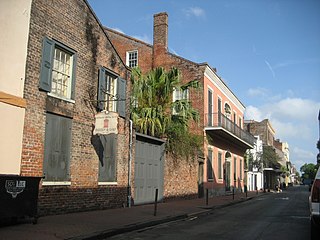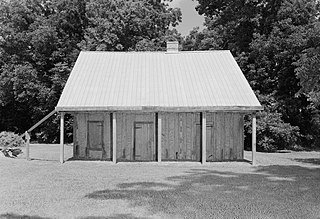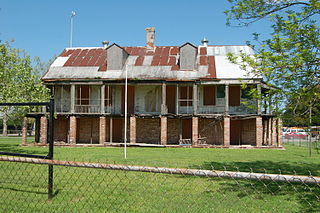
Fort de Chartres was a French fortification first built in 1720 on the east bank of the Mississippi River in present-day Illinois. It was used as the administrative center for the province, which was part of New France. Due generally to river floods, the fort was rebuilt twice, the last time in limestone in the 1750s in the era of French colonial control over Louisiana and the Illinois Country.
Plaçage was a recognized extralegal system in French and Spanish slave colonies of North America by which ethnic European men entered into civil unions with non-Europeans of African, Native American and mixed-race descent. The term comes from the French placer meaning "to place with". The women were not legally recognized as wives but were known as placées; their relationships were recognized among the free people of color as mariages de la main gauche or left-handed marriages. They became institutionalized with contracts or negotiations that settled property on the woman and her children and, in some cases, gave them freedom if they were enslaved. The system flourished throughout the French and Spanish colonial periods, reaching its zenith during the latter, between 1769 and 1803.

Destrehan Plantation is an antebellum mansion, in the French Colonial style, modified with Greek Revival architectural elements. It is located in southeast Louisiana, near the town of the same name, Destrehan.
Marie Thérèse Coincoin, born as Coincoin, also known as Marie Thérèse dite Coincoin, and Marie Thérèse Métoyer, was a planter, slave owner, and businesswoman at the colonial Louisiana outpost of Natchitoches.
Isle of Canes (ISBN 1-59331-306-3), a novel by Elizabeth Shown Mills, follows an African family from its importation and enslavement in 1735 through four generations of freedom in Creole Louisiana to its re-subjugation by Jim Crow at the close of the nineteenth century. Mills explores the family's "struggle to find a place in [a] tightly defined world of black and white" — a world made more complex by the larger struggle of Louisiana's native ancien regime to preserve its culture amid the Anglo-Protestant "invasion" that followed the Louisiana Purchase of 1803 and the resulting battle for political and social hegemony. Isle's central theme is the ambiguous lives of those who escaped colonial slavery only to find they could not survive as free without complicity in the slave regime.

Laura Plantation is a restored historic Louisiana Creole plantation on the west bank of the Mississippi River near Vacherie, Louisiana, (U.S.), open for guided tours. Formerly known as Duparc Plantation, it is significant for its early 19th-century Créole-style raised big house and several surviving outbuildings, including two slave cabins. It is one of only 15 plantation complexes in Louisiana with this many complete structures. Because of its historical importance, the plantation is on the National Register of Historic Places. The site, in St. James Parish, Louisiana, is also included on the Louisiana African American Heritage Trail.

The Creoles of color are a historic ethnic group of Creole people that developed in the former French and Spanish colonies of Louisiana, Mississippi, Alabama, and Northwestern Florida, in what is now the United States. French colonists in Louisiana first used the term "Creole" to refer to people born in the colony, rather than in France.

The Hermann–Grima House is a historic house museum in the French Quarter of New Orleans, Louisiana. The meticulously restored home reflects 19th century New Orleans. It is a handsome Federal-style mansion with courtyard garden, built in 1831. It has the only extant horse stable and 1830s open-hearth kitchen in the French Quarter.

Oakland Plantation, originally known as the Jean Pierre Emmanuel Prud'homme Plantation, and also known as Bermuda, is a historic plantation in and unincorporated area of Natchitoches Parish, Louisiana. Founded as a forced-labor farm worked by enslaved Black people for White owners, it is one of the nation's best and most intact examples of a French Creole cotton plantation complex. The Oakland Plantation is now owned by the National Park Service as part of the Cane River Creole National Historical Park.

Magnolia Plantation is a former cotton plantation in Natchitoches Parish, Louisiana. The site was declared a National Historic Landmark in 2001, significant as one of the most intact 19th-century plantation complexes in the nation, as it is complete with a suite of slave cabins and numerous outbuildings and period technology. Included in the Cane River Creole National Historical Park, Magnolia Plantation is also a destination on the Louisiana African American Heritage Trail. It is one of two plantations in the park; the other is Oakland Plantation.

Melrose Plantation, also known as Yucca Plantation, is a National Historic Landmark located in the unincorporated community of Melrose in Natchitoches Parish in north central Louisiana. This is one of the largest plantations in the United States built by and for free blacks. The land was granted to Louis Metoyer, who had the "Big House" built beginning about 1832. He was a son of Marie Thérèse Coincoin, a former slave who became a wealthy businesswoman in the area, and Claude Thomas Pierre Métoyer. The house was completed in 1833 after Louis' death by his son Jean Baptiste Louis Metoyer. The Metoyers were free people of color for four generations before the American Civil War.

The Ste. Genevieve National Historical Park, established in 2020, consists of part or the whole of the area of the Ste. Genevieve Historic District, which is a historic district encompassing much of the built environment of Ste. Genevieve, Missouri, United States. The city was in the late 18th century the capital of Spanish Louisiana, and, at its original location a few miles south, capital of French Louisiana as well. A large area of the city, including fields along the Mississippi River, is a National Historic Landmark District designated in 1960, for its historically French architecture and land-use patterns, while a smaller area, encompassing the parts of the city historically important between about 1790 and 1950, was named separately to the National Register of Historic Places in 2002.

St. Augustine Catholic Church and Cemetery, or the Isle Brevelle Church, is a historic Catholic parish property founded in 1829 near Melrose, Natchitoches Parish, Louisiana. It is the cultural center of the Cane River area's historic Black Creole community.

The LaBranche Plantation Dependency House is located in St. Rose, St. Charles Parish, Louisiana. From many accounts, LaBranche Plantation in St. Rose, Louisiana, was one of the grandest on the German Coast until it was destroyed during the Civil War. All that remained was the dependency house, known as a garconnière.

The Badin-Roque House is a historic house located along Louisiana Highway 484, about 6.6 miles (10.6 km) southeast of Natchez in the community of Isle Brevelle.

The Martin Donato House, in St. Landry Parish, Louisiana, was built around 1825. It was listed on the National Register of Historic Places in 2005.

Dorvin House, near Hahnville, Louisiana, was built around 1840 to 1850. It was listed on the National Register of Historic Places in 1990. It has also been known as Mollere House and as Rosedon.

Cherokee Plantation, also known as Emile Sompayrac Place and Murphy Place, is a former plantation and historic plantation house located in Natchez, Louisiana, near the city of Natchitoches. For many years this site was worked and maintained by enslaved African Americans. This location was part of the Côte Joyeuse area which was home to the earliest French planters in Louisiana.

Narcisse Prudhomme Plantation, also known as Narcisse Prud'homme Plantation, Beau Fort Plantation, and St. Charles Plantation, is a historic planation house and a former plantation, located in the unincorporated community of Bermuda, Louisiana near the village of Natchez. It is one of the oldest plantations in the Cane River National Heritage Area.

Godchaux–Reserve Plantation, also known as Godchaux–Boudousquie Plantation, and the Reserve Plantation, is a former plantation, former site of a sugar refinery, and once included a historic house built in 1764, located in Reserve, St. John the Baptist Parish, Louisiana.




















